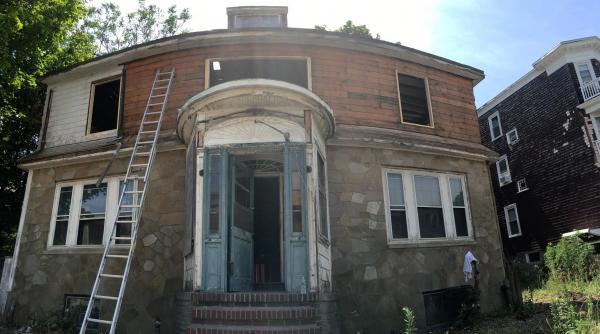July 21, 2016

The City of Boston's Dept. of Neighborhood Development is renovating this house on Stoughton Street that has been a longtime eyesore in the neighborhood. Jenn Smith photo
A staple on the city’s distressed properties list, 139 Stoughton St. has long been the subject of complaints from abutters. But hope is in sight for the neighbors: The flagstone-faced residence is now being rehabilitated through the Neighborhood Homes Initiative managed by the city’s Department of Neighborhood Development (DND).
When the work is finished later this year, the property will be marketed as a two-family home with a first-floor rental unit. Its burned-out top floor will be converted into a roomy, three-bedroom apartment. The ground floor, once used as a office and viewing area for a nearby funeral parlor, will feature new bathrooms, bedrooms, and a kitchen. And a basement once inhabited by a hoarder living utility-free will revert to normal use.
Renovating an existing building is a rarity for the program, said William Epperson, senior project manager with DND. Lots that pass through the Neighborhood Homes Initiative are generally vacant, and developers build homes from the ground up. While rehabilitating a decrepit standing property is more of a time drain than starting from scratch, the city prioritizes maintaining the current housing stock.
“I wouldn’t say that it’s necessarily an historic building,” Epperson said. “It’s just an old building. An old, beautiful building. And whenever possible, we’d like to save those old, beautiful buildings, as opposed to just tearing them down and building something new.”
My Lam, with Escazu Development LLC, is overseeing construction on the site. This is Lam’s second home rehab through the city program, the first being a smaller family building.
“The city’s making really every effort to get these properties out and to get guys to come and bid to work on them,” Lam said on a tour of the site Tuesday. He estimates rehabbing the house is about a two-and-and-half-month project, to be completed in September.
Both units will be restricted to 100 percent area median income, one a homeownership unit for a first-time homeowner and the second a rental unit which would help offset the mortgage. The rental component will finish up at about 1,000 square feet, with the duplex homeownership unit between 1,800 and 1,900 square feet, Lam said.
The property was formerly zoned and used as a one-family residence with a funeral parlor. The family that operated it had a funeral home in the neighborhood, where all medical procedures took place. The home went out of business a number of years ago, Epperson said, and the city acquired the property through tax foreclosure in 2013. After a year of community process, DND asked for proposals to turn the lot into a two-family affordable home and closed with a sale to Lam this June.
Most of the house was in shambles, Epperson said. “It didn’t actually meet current housing code. It wouldn’t have met the habitability code.”
Despite the building’s former usage, no unsavory elements related to the funeral home were uncovered once the city took possession of the property. Police responded in 2013 to reports of possible human remains at the site, but police said Tuesday that no such remains were discovered.
A fire decades ago had burned out the second-floor residence. “The house was in severe disrepair,” Epperson said, “just decades of neglect caused the building to fall apart. So, that’s why we needed all new plumbing, all new heating, all new electrical. All of the windows needed to be replaced. The exterior envelope of the building needed to be redone to make it weather-tight.”
On top of that work, structural repairs were necessary throughout the house, which currently stands open to the elements on several fronts.
On a tour of the property this week, Lam pointed out the sites for new bathrooms, kitchens, and dining rooms. The future owners will reap the joint benefits of a classic colonial-style home and a refurbished, spacious interior.
Lam and the city expect a good bit of demand for the building and the lot, which will likely be priced in the mid- to high-$400,000 range. “The highlight of it is we’re preserving a building. We’re creating new units of affordable housing at no subsidy cost to the city, other than a reduced acquisition price for the land. I think that’s kind of the whole objective,” Epperson said.
Villages:


